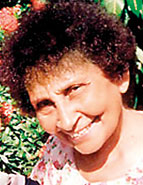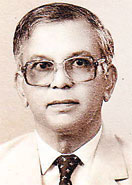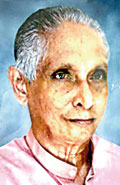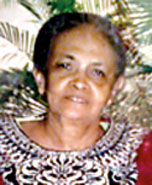Fr. Roy Henry Bowyer-Yin arrived at S.Thomas’ College, Mt. Lavinia on December 26, 1946, to act temporarily as the chaplain but remained till December 1962.
During those 16 years Fr. Yin had a major impact on our lives due to his clear and incisive mind reflected in his neat handwriting and sign ‘Rhby’. It was clearly so in his 3Ms of life-Music, Mathematics and Ministry.
He was born in Singapore on October 7, 1910 to a Chinese surgeon father Dr. Yin Suat Chwan and an English mother Lydia Florence Bowyer.
In 1919 his mother took him and his elder brother Leslie back to England. Roy entered Kings College Cambridge (KCC) and graduated in 1932. Whilst at KCC he had the divine call to be a priest.
He had a year’s training at Cuddlestone Theological College, Oxford and was made a Deacon at the minimum age, one day after his 23rd birthday.
It was the first ordination at the ancient Kings College Cambridge Chapel, and he became its Chaplain from 1933-1937 under its Dean, Eric Milner White, creator of the now famous Christmas Festival of 9 Lessons and Carols Service.
This service was first done as a thanksgiving for peace in 1918 soon after World War I. Significantly Fr. Yin too first had this same KCC service at S. Thomas College on December 7, 1947 after the end of World War II.
Fr. Yin’s brother, changed his name to Leslie Charteris and became a crime fiction novelist, the creator of the famous ‘Saint’ books. Fr. Yin donated the entire series to the STC Library.
The yearning to teach made him move to Hurstpierpoint College, Sussex as Chaplain, and Maths and Choir Master from 1937-1946. He brought in a young student as the organist, Meridith Davies (just as later he did the same at STC in Lucien Netthasinghe, Lucien Fernando and Russel Bartholemeusz), and both of them wrote a new melody for the Eton College Headmaster C.A.Alington’s hymn ‘Lord Thou hast brought us to our journey’s end’, and named the tune ‘Hurstpierpoint’. This later became the end of term hymn at Mount Lavinia. At age 96, Fr. Yin played it on the piano by memory with a deft touch when A.G. Nihal De Silva and F.V. Chris Mendis visited him in Singapore.
This was sung at Fr. Yin’s funeral with the two famous Thomian singers, the Lanerolle Brothers Rohan and Ishan, leading the choir at St. Andrew’s Cathedral and also played as a postlude (-see U-Tube), commented as the best music of the event.
Fr. Roy Bowyer-Yin was different things to different boys at ‘the school by the sea’ – another song composed by him. He was an excellent mathematics master and taught around the subject which held his students in good stead later in life. “The syllabus is only a scrap of paper,” he would say, “You learn maths not because it’s useful but because it is beautiful.”
His prowess in teaching music as the choir master was even better, and emphasized the importance of sight singing musical scores. The high standard of choral music at the Chapel he set from his first year continues as a Thomian tradition-because he infused a love for choral and classical music and the fine arts to his students and they to theirs and theirs to the present. Again as a Divinity Master and in his Confirmation classes he always encouraged a spirit of enquiry and questioning conventional ideas, always instilling values.
It was in his ministry that he really excelled, touched the hearts of many and became a trail blazer. He was in the side chapel every morning at 6 a.m. to start Matins (-structured Morning Prayer) joined by the Warden and Fr. Barnabas and later Fr. Baldwin Daniel and a few others, followed by the Daily Eucharist – a discipline now forgotten at STC for many years.
His sermons so well prepared were models of lucidity, brevity and completeness. He would say with mathematical clarity, “For every minute above 12 minutes you knock off 1 minute of value to your sermon, and if you go upto 24 minutes, you might as well not have started.”
The hymns he chose were sound in theology, language and music and always thoroughly rehearsed. Then there was the drama of reverent movement by the servers and readers and finally the full participation of all with all their senses, making a 4 square offering of beauty and elegance in all his meticulously planned services/liturgy (originally in Greek meaning public works) that it added to the holiness of the ambience of the Chapel he loved so well, second only to God.
He brought a welcome change in the funeral and memorial services to make them triumphant proclamations of Christian belief and yet comforting the mourners.
He changed the Christmas tableau and carols to the now famous King’s Festival of 9 lessons and carols. He introduced the Liturgical Choral 3 Hours Service on Good Friday, then new in England but now much developed, but the STC service remains a museum piece. For him tradition is dynamic.
He even conceived the idea of a mural/icon of the Transfiguration at the blank east wall of the Chapel that had so existed since the beginning.
Fr. Yin wanted us to “build upon and improve what under God I endeavoured to begin”. Even the current tradition of writing the name of the College without a ‘t’ in ‘St’ is what he instituted.
His last sermon to the boys on December 8, 1962 was memorable. “S. Thomas’ is you. It depends on our maintaining Christian standards of honesty and integrity and commitment to God,” he said.
Fr. Yin was a stickler for punctuality and discipline, done with biting and yet humorous remarks that cut us down to size without hurt but to be always remembered.
He shared with Warden De Saram the view that as Euclid’s Geometry defines a point as a position with neither length nor breadth and thus is unstretchable , there is no ‘stretching a point’ when it came to rules, standards and discipline. End of story!
Clerus Anglicanus stupor mundi – An Anglican clergyperson is a wonder of the world. At STC, Rev. Roy Henry Bowyer – Yin was just that.
The switch to Swabasha compelled Fr. Yin to return in 1963 to the country of his birth, Singapore where he continued to teach maths well into his eighties, continued his love for music as the Precentor and Canon of the Cathedral, and continue his Ministry as a Vicar and then as a counsellor and social worker well into his 90s.
He was cared for by his adopted grandson Attorney Andrew Ang and his wife Valerie. It was fitting that Warden Puddefoot was present at his 100th birthday in October 2010.
He died on Tuesday, December 14, 2010. A good innings – ‘He had done what he could’(as the Bible says).
He is at peace and in Christ ‘memory eternal’ to rise in glory on the Last Day.
Dr. Narme F. Wickremesinghe
Her music and cheery nature spread joy
Elieen Prins
The late Eileen Prins – musician and music teacher – passed away on June 20, 2011, and was remembered recently when her family observed the local tradition of an almsgiving in memory of the departed person, three months on.
At the Eileen Prins Memorial Service, at St. Mary’s Church, Bambalapitiya, on July 28, there were tributes and there was music, especially fitting for someone who gave her life to music, and celebrated and enriched so many lives through music.
Mother will be remembered not only for her contribution to the world of music, but also for her wonderfully cheery, engaging and encouraging qualities as a parent, teacher, and friend. These qualities she projected with the same radiance and joy she brought to her music-making.
Having the memorial service at St. Mary’s Church was significant. It was Mother’s church – the place where she was baptised, in May 1917, and the venue where she was married, in 1946, shortly after she and Father, Jocelyn Frederick (Deryk) Richard Prins, returned from England, where they had spent the war years as students, one at Oxford, the other at the Royal Academy of Music, London.
St. Mary’s was very dear to Mother. She never missed Sunday Mass, from the time she was taken there as a child by her parents, and through the years that she took her three sons to Mass, and then in later years, when she would go to church on her own, until she was too old or unwell to carry out her public Sunday religious obligations.
Not long ago, as a semi-invalid, she visited St. Mary's. We did a tour of the Church and strolled in the church garden, and Mother said she would often see herself in dreams visiting the church and walking through those same grounds.
When people talk of Eileen Prins, they immediately visualise Mother with her beloved violin. Her students would talk of “Aunty Eileen with her Violeen!”
As a teacher, Mother groomed hundreds of students and gave thousands of hours of dedicated, quality teaching in a career that spanned more than 60 years.
As a performer, the distinctive voice of Mother’s violin was heard in churches, concert halls, recital halls, embassies, churches, school halls, hotel ballrooms, grand homes, and of course her own humble, music-filled home.
The sound of the violin – solo or in concert – was central to the world of Eileen Prins.
Mother was in equal parts a romantic and a realist. She had an amazing ability to balance her music with the practical demands of being a mother, housewife, teacher, good neighbour and citizen.
The moment she picked up her violin, she was a transformed being, singing her heart out through her beloved instrument, and moving people to tears with her artistry. And when she was done with her ethereal music making, she was back in the everyday business of being a level-headed housewife, mother, and teacher.
One thing Mother never lost sight of was the beauty that surrounded her life and filled her world. She never failed to comment on beauty wherever she encountered it: a job well or beautifully done; the colour of a flower or a sunset, someone’s beautiful speaking voice, a muezzin splendidly singing the morning prayer from a neighbourhood mosque; a beautiful child; the beauty in the face of an elderly person who would have been a beautiful person in earlier years. Through her, we learnt to see beauty, listen for beauty, look out for beauty.
To judge by photographs in the family album, Mother was a beautiful person herself, and this beauty showed to the end in a face that was ever smiling.
And beautiful things had a wonderful way of happening to her.
Two beautiful things happened to her, shortly before her death, and shortly after.
She had to spend her 94th birthday in a hospital bed (she had been in and out of hospital over the past six months). On May 27, her birthday, a rose bloomed in the garden of her home, at No. 35 School Lane, Colombo 3. This somewhat neglected plant had not produced roses in a while, but that day it turned out a beautiful bloom. We took it to hospital as one of Mother’s birthday gifts. We told her it was from the garden. She smiled.
And then, at her funeral, on June 22, as the priest read out the prayers at her graveside, he spoke the words, “And may the sun smile upon your face.” Just then, with split-second timing, the late afternoon sun came out from behind a cloud and irradiated the cemetery – and the city. It was a little miracle of synchronicity.
One striking quality about Mother was her faith that somehow she would not be let down if she believed strongly enough. Her great faith was her great strength. She knew that in lean times somehow she would pull through, and the family with her. That faith never failed her. She loved to quote from St. Matthew:
"Look at the birds of the air, for they neither sow nor reap nor gather into barns; yet your heavenly Father feeds them. Are you not of more value than they?"
And again, from further on in the sermon:
"Therefore do not worry, saying, "What shall we eat?' or "What shall we drink?' or "What shall we wear?' . . . For your heavenly Father knows that you need all these things."
Music was at the heart of everything Mother did, and she lived her religion through her music. She led the orchestras and chamber music groups of Colombo through umpteen religious services and concerts of religious music. In the ’50s and ’60s, there were the concerts with the Catholic Choral Society in the beautiful chapel of St. Joseph’s College, concerts led by the late Father Ignatius Perera and which included works by Pergolesi, Scarlatti, Purcell, and Rossini, including at least two versions of the Stabat Mater; performances in the ’60s of Bach’s St. Matthew’s Passion and Handel’s Messiah under Gerald Cooray; the Mozart Requiem, under Paul Jayarajan; concerts in the ’70s with Father Claver Perera, which included annual Christmas events at St. Peter’s College and St. Mary’s Church, Bambalapitiya; and memorable concerts with Raymond Adlam, of the British Council – performances of the Fauré Requiem, the Verdi Requiem, and Benjamin Britten’s St. Nicholas Cantata, at St. Andrew’s Church, Kollupitiya. It was an interesting endorsement of Mother’s musicianship to hear the formidable music critic, music teacher and musician, the late Elmer de Haan, comment on Eileen Prins, the violinist.
Mr. de Haan was an old family friend who had heard Mother as a schoolgirl performing at school prize-givings, back in the ’30s. On one occasion, in the late ’60s, he told one son, “I never heard your Mother ever play an out-of-tune note. She was incapable of playing off key.”
He added that “she excelled in quiet, soulful playing, as in the slow movements, where she could display her unique tone to full advantage. She was not one to impress with virtuosity. Hers was meditative playing.”
Mr. de Haan went on to say, flatteringly comparing an element of her artistry to that of a concert artist great, that “she had a very special tone, plaintive, melancholy almost, that recalled the great Fritz Kreisler. There was a distant, wailing element in the sound she produced, a sound you’d hear in Kreisler.”
It was fitting that star students of Mother's performed at her memorial service. The music included her beloved Johann Sebastian Bach.
Indeed, it was an unusual private service for a Roman Catholic Church – intimate, conversational, and part eulogy, part religious service, part private concert.
It was a service Eileen Prins would have enjoyed.
Jan (Hawaii), Stephen, and Paul
A leader to all he empathized with and served the poor
Mohamed Haleem Ishak
September 24 marked the eighth death anniversary of a respected leader of the Muslim community who served his people and the country for over half a century.
He was a gentleman in politics loved by all, serving mainly the poor and the oppressed, a respected municipal councillor and parliamentarian. The kind of politics he was engaged in should be a lesson to politicians of today.
Like the respected Sir Razik Fareed he worked without racial, religious and communal differences promoting his famous slogan, “Sinhala-Yonaka Ekamuthukama” , the Sinhala – Moor Unity in Sri Lanka.
He was the grand-son of the philanthropist the late A.M. Nagoor Meera whose sons were the late N.M. M. Ishak ( 1901 – 1965 ) and late N.M.M. Haniffa ( 1893 – 1949 ), the father of M.H.Mohamed.
He was born on December 9, 1929 at N.M.M.Ishak Mawatha, named after his father for his services. The Ketawalamulla Lane, the road adjoining this was named recently after him as “M. Haleem Ishak Mawatha” for his services to the community.
Haleem Ishak joined the SLFP in 1955 and became its vice president. He successfully contested the Maradana Municipal Ward in the CMC and represented the Kuppiawatta- East Ward. He was not only popular among the Muslims of Sri Lanka but also the Buddhists.
Kuppiawatta - East Ward consists of a population of 80 % Buddhists and the largest number of temples in the City of Colombo is found in this Ward.
His honesty, and simplicity were well known and his gentleman politics was emulated by others. In July 1977 the Sri Lanka Freedom Party was routed badly but Haleem Ishak was elected to Parliament to the Colombo Central Constituency as the third member. He was a parliamentarian for nearly two decades.
The SLFP government that was in power before his death offered him a diplomatic post which he declined, saying he wanted to remain in the country and serve the poor until his death.
A.H.G. Ameen
Till we
meet again
Malinda and
Malini Ranatunga
Whatever we do, wherever we go, there is one thing which is never forgotten.
That is our love for both of you.
No one can fill your place in our hearts. We loved both of you then, and we love you still. Although our eyes might not be able to look upon your gentle loving faces, if we look with our hearts we still see your love.
We love both of you and miss you even more. We pray to meet again as our loving parents in our future lives.
Badrika, Ishani &
Chamila
(A bana preaching and
almsgiving in their memory will be held on October 10 and 11.)
When I
pass you
Michael Caderamanpulle
When I pass you, the sky will turn around and look at you
When I pass you, the salaniya will call in other languages
When I pass you, the Koi fish will swirl around and around in the pond
When I pass you, the orchids will nod gently in the breeze
When I pass you, the guava will fall from the trees into your hands
When I pass you
I will take nothing, not even your fingerprints.
Charmanie Candappa
|





